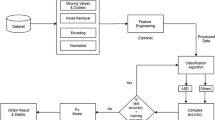Abstract
Machine Learning presents a brand new method of predicting children with Autism Spectrum Disorder (ASD) in an early stage with different behavioral analytics. Predicting autistic’s characters through screening trials is very high-priced and long duration. According to the facts of WHO, the variety of patients identified with ASD is steadily growing. Such children are essentially not able to interact with others, put off with the acquisition of linguistic, Cognitive, repetitive behavioral, speech, and non-verbal communique. The goal of the paper is to awareness of the early deduction of ASD from the affected individual. Feature engineering is a process that extracts the appropriate features from the dataset for predictive modeling. In this study, features are analyzed and reduce in three different datasets of ASD with the categories of age. The reduced feature set is investigated with the machine learning classifiers such as SVM, RANDOM FOREST (RF), KNN. The overall performance of the prognostic models is classified in the frame of accuracy and sensitivity performance metrics. In precise, the RF method categorized the data with higher precision for ASD datasets.
Access this chapter
Tax calculation will be finalised at checkout
Purchases are for personal use only
Similar content being viewed by others
References
Zhou, T., Xie, Y., Zou, X., & Li, M. (2017). An automated assessment framework for speech abnormalities related to autism spectrum disorder. In 3rd International Workshop on Affective Social Multimedia Computing (ASMMC).
Goin-Kochel, R. P., Mackintosh, V. H., & Myers, B. J. (2006). How many doctors does it take to make an autism spectrum diagnosis? Autism, 10(5), 439–451. https://doi.org/10.1177/1362361306066601.
Thabtah, F., & Peebles, D. (2020). A new machine learning model based on induction of rules for autism detection. Health Informatics Journal, 26(1), 264–286. https://doi.org/10.1177/1460458218824711.
Ali, J., Khan, R., Ahmad, N., & Maqsood, I. (2012). Random forests and decision trees. International Journal of Computer science Issues, 9.
Alwidian, J., Elhassan, A., & Rawan, G. (2020). Predicting autism spectrum disorder using machine learning technique. International Journal of Recent Technology and Engineering, 8, 4139–4143. ISSN: 2277-3878.
Erkan, U., & Thanh, D. (2019). Autism spectrum disorder detection with machine learning methods. Current Psychiatry Research and Reviews, 15, 297–308.
Bone, D., Goodwin, M. S., Black, M. P., Lee, C. C., Audhkhasi, K., & Narayanan, S. (2015). Applying machine learning to facilitate autism diagnostics: Pitfalls and promises. Journal of Autism and Developmental Disorders, 45(5), 1121–1136. https://doi.org/10.1007/s10803-014-2268-6.
Abdullah, A. A., et al. (2019). Evaluation on machine learning algorithms for classification of autism spectrum disorder (ASD). In International Conference on Biomedical Engineering. Journal of Physics: Conference Series, 1372, 012052.
Association, A. P. (2013). Diagnostic and statistical manual of mental disorders: DSM-5. Washington, DC: American Psychiatric Association.
Wang, H., Li, L., Chi, L., & Zhao, Z. (2019). Autism screening using deep embedding representation. In International Conference on Computational Science. https://doi.org/10.1007/978-3-030-22741-8_12.
Alarifi, H. S., & Young, G. S. (2018). Using multiple machine learning algorithms to predict autism in children. In International Conference on Artificial Intelligence (pp. 464–467).
Akyol, K., Gultepe, Y., & Karaci, A. (2018). A study on autistic spectrum disorder for children based on feature selection and fuzzy rule. In International Congress on Engineering and Life Science (pp. 804–807).
Thabtah, F. (2019). An accessible and efficient autism screening method for behavioral data and predictive analyses. Health Informatics Journal, 25(4), 1739–1755. https://doi.org/10.1177/1460458218796636.
Shihab, A., Dawood, F., & Kashmar, A. H. (2020). Data analysis and classification of autism spectrum disorder using principal component analysis. Advances in Bioinformatics. https://doi.org/10.1155/2020/3407907.
Islam, M. N., Omar, K., Mondal, P., Khan, N., & Rizvi, M. (2019). A machine learning approach to predict autism spectrum disorder. In International Conference on Electrical, Computer and Communication Engineering. https://doi.org/1109/ECACE.2019.8679454.
Padmapriya, M. (2018). A novel feature selection method for pre-processing the ASD dataset. International Journal of Pure and Applied Mathematics, 118, 17–24.
Pedregosa, F., Varoquaux, G., Gramfort, A., Michel, V., Thirion, B., Grisel, O., et al. (2011). Scikit-learn: Machine learning in python. Journal of Machine Learning Research, 12, 2825–2830.
Kupper, C., Stroth, S., Wolff, N., et al. (2020). Identifying predictive features of autism spectrum disorders in a clinical sample of adolescents and adults using machine learning. Scientific Reports, 10(1), 4805. https://doi.org/10.1038/s41598-020-61607-w.
Vaishali, R., & Sasikala, R. (2018). A machine learning based approach to classify autism with optimum behavior sets. International Journal of Engineering & Technology. https://doi.org/10.14419/ijet.v7i4.18.14907.
UCI machine learning repository. Retrieved https://Archive.Ics.Uci.Edu/ML/Index.Php.
Thabtah, F. (2017). ASDTests. A mobile app for ASD screening [Internet] [cited December 20, 2018]. Available from: www.asdtests.com.
Thabtah, F. (2017). Autism spectrum disorder screening: Machine learning adaptation and DSM-5 fulfillment. In ICMHI ’17 Proceedings of the 1st International Conference on Medical and Health Informatics. https://doi.org/10.1145/3107514.3107515.
Raschka, S. (2015). Python machine learning, September 2015. ISBN: 978-1-78355-513-0. www.packtpub.com.
Vapnik, V. N. (1995). The nature of statistical learning theory. New York: Springer.
Qi, Y. (2012). Random forest for bioinformatics. In C. Zhang & Y. Ma (Eds.), Ensemble machine learning. Boston, MA: Springer. https://doi.org/10.1007/978-1-4419-9326-7_11.
Joachims, T. (1998). Text categorization with support vector machines: Learning with many relevant features. In 10th European Conference on Machine Learning (pp. 137–142).
Tanvi, S., Anand, S., &Vibhakar M. (2016). Perfomance analysis of data mining classification techniques on public health care data. International Journal of Innovative Research in Computer and Communication Engineering, 4, 11381–11386.
Author information
Authors and Affiliations
Corresponding author
Editor information
Editors and Affiliations
Rights and permissions
Copyright information
© 2021 The Author(s), under exclusive license to Springer Nature Switzerland AG
About this paper
Cite this paper
Priya, N., Radhika, C. (2021). Prediction of Autism Spectrum Disorder Using Feature Engineering for Machine Learning Classifiers. In: Favorskaya, M.N., Peng, SL., Simic, M., Alhadidi, B., Pal, S. (eds) Intelligent Computing Paradigm and Cutting-edge Technologies. ICICCT 2020. Learning and Analytics in Intelligent Systems, vol 21. Springer, Cham. https://doi.org/10.1007/978-3-030-65407-8_5
Download citation
DOI: https://doi.org/10.1007/978-3-030-65407-8_5
Published:
Publisher Name: Springer, Cham
Print ISBN: 978-3-030-65406-1
Online ISBN: 978-3-030-65407-8
eBook Packages: Intelligent Technologies and RoboticsIntelligent Technologies and Robotics (R0)




